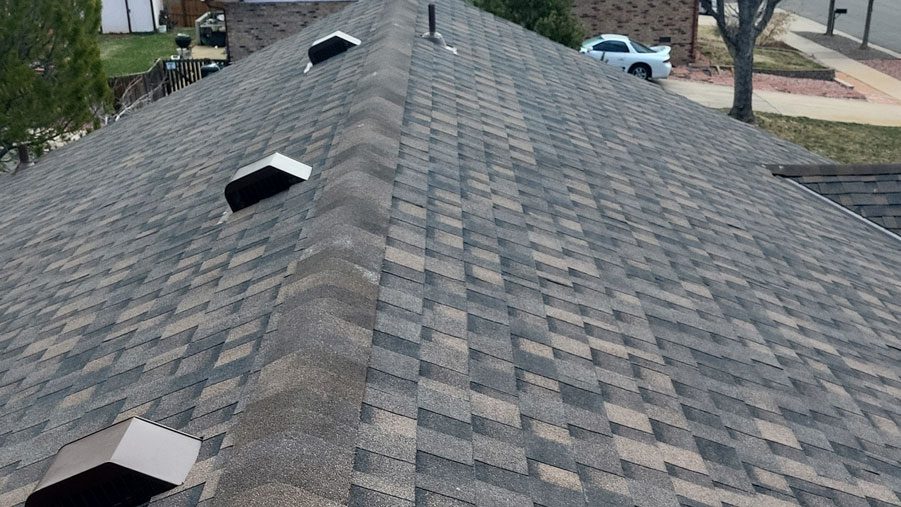How to Match Your roof with your home's exterior color scheme
My husband and I have been in the roofing and exteriors business since 2014 and have worked in home improvement for over 30 years. We’ve seen a lot of roofs get replaced, not just in Colorado but all over the country, especially when we’ve helped after hurricanes on the Gulf Coast. Even with all this experience, we still learn something new with every roofing project about how the right roof can truly transform a home.
As roofing contractors, we know that homeowners aren’t usually excited about getting a new roof. But your roof does more than just keep out the weather—it also covers about 40% of what people see when they first look at your home. The outside of your house is often the first thing people notice, and picking the right roof color can make a big difference in how your home looks.
So, how do you pick the right roof color? This choice will affect how your home looks for many years, so it’s important to choose carefully. In this guide, we’ll show you how to match your roof with the colors of the rest of your house. Our goal is to help you make a choice that looks good and adds to your home’s strength, value, and appearance.
Understand Color Theory
Having replaced roofs on every color house there is, it became quickly clear that you need a basic understanding of color theory to ensure your color scheme looks seamless. The color theory is a valuable tool when choosing a color scheme. It explains what colors look good together and why.

The basics of the color theory are simple. Colors are divided into three categories: primary (red, blue, yellow), secondary (green, orange, purple), and tertiary (combinations of primary and secondary colors). When creating an exterior color scheme, it’s helpful to know which colors complement each other. Complementary colors are opposite each other on the color wheel, like blue and orange or red and green. These combinations are visually striking and can bring a vibrant look to your home. We have absolutely seen red, green, blue, and white roofs. While most modern homes stick to brown or black, roofs are available in a variety of colors. This is particularly true for metal panel roofs, as they are available in almost every color. With this in mind, it’s helpful to know which colors complement each other.
Analogous Colors
Analogous colors are those that sit next to each other on the color wheel, sharing a common hue that makes them blend perfectly. This group includes three colors that are side by side, like blue, blue-green, and green or red, red-orange, and orange. When these colors are used together, they create a serene and comfortable look because of their close relationship in the color scheme.
When choosing a roof replacement with these colors, you can create a very subtle and harmonious appearance. We have seen dark green roofing paired with lighter shades of green throughout the siding and the trim or a grey-blue roof, with shades of blue making up the color palette of the home.
When designing a color scheme using analogous colors:
- Identify the dominant color of your pallette.
- Choose your roofing material in a coordinating hue.
- Create depth using a darker or more saturated version of the adjacent colors for accents.
- Choose a color on either side of the dominant siding color.
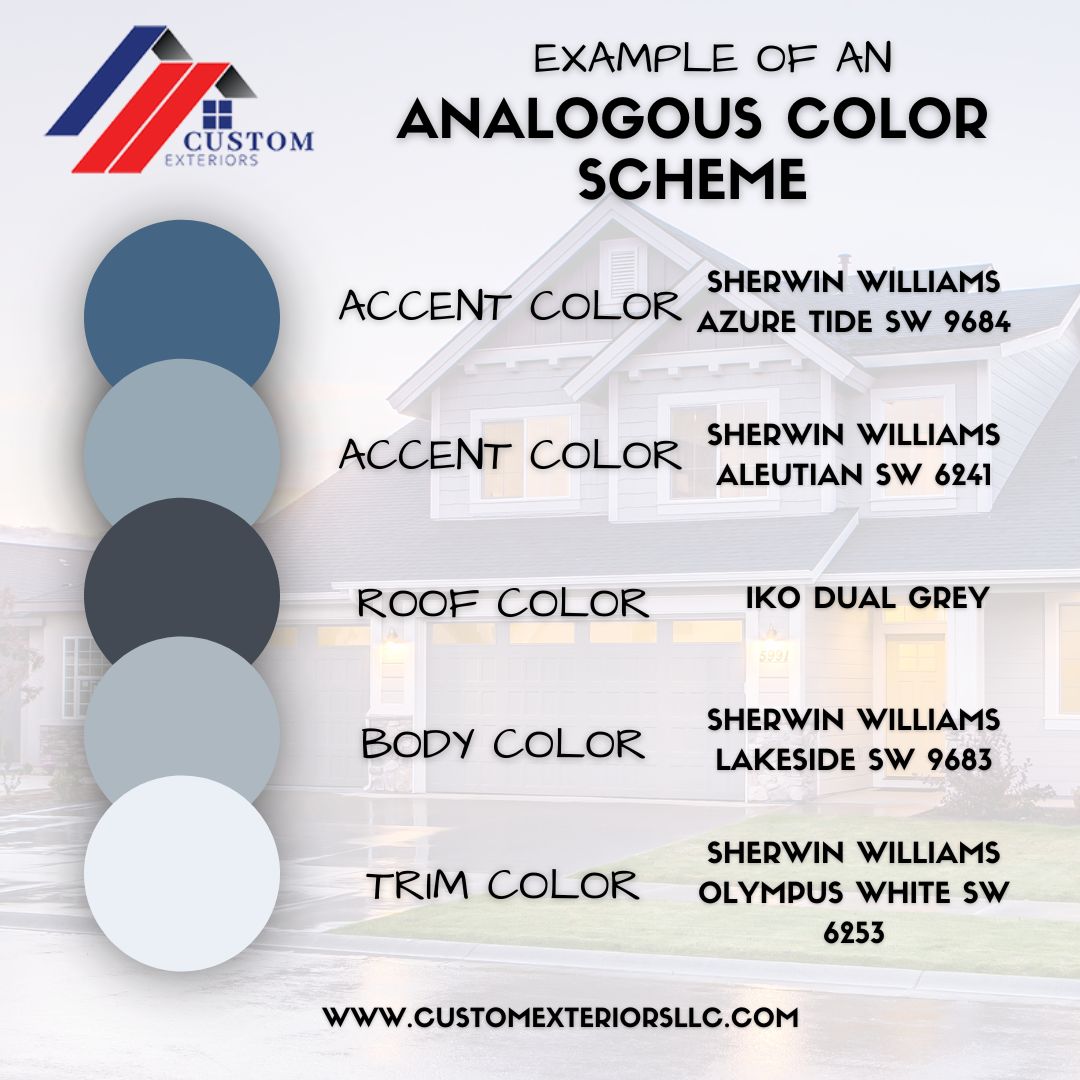
As you can see from the example above, using analogous colors in roofing and siding projects not only makes the color choices easier but also makes sure your house looks great. This approach allows for a calm and cohesive exterior appearance.
It’s important to consider the saturation and brightness of your color choices as well. Saturation refers to how intense or vivid a color is, while brightness refers to how light or dark a color is. A roof that is too bright or saturated might overwhelm your home’s exterior, while a more muted color of the same tone can tie things together beautifully.
Assessing Your current exterior
Choosing a roof color that blends well with your existing home color scheme involves careful consideration. Because your exterior plays a huge role in your home’s first impression, it’s a decision that shouldn’t be taken lightly. Here’s how you can systematically approach the process:
- Assess the Current Colors: Start by observing the main colors on your home’s exterior, including the siding, doors, windows, and trim. Remember, lighting can significantly alter color perception, so it’s best to view the colors at different times of the day.
- Understand Undertones: Look at the undertones in the existing colors. For example, a beige might have a pink, yellow, or green undertone. These undertones are crucial for properly matching colors. Your roof color should complement these undertones, not clash with them.
- Consider the Visual Impact of a Roof Color: The roof can make up to 40% of your home’s visible exterior, making its color a significant factor in your curb appeal. A roof color that complements the main color scheme can transform your home, making it appear balanced and integrated. For example, if your home has warm beige siding with yellow undertones, a brown or warm gray roof can be a perfect match.
- Use Color Swatches: Obtain color swatches for potential roof materials and compare them alongside your home’s exterior in natural light. This is the most effective way to ensure the colors work well together. Most roofing materials are available through your local roofing company in 2-foot sample sections.
- Factor in Material and Texture: Remember that the material and texture of the roofing will influence its color and appearance. A shiny metal panel roof will reflect more light and could appear lighter than it is. On the other hand, standard asphalt shingles absorb light, which sometimes makes them appear deeper in color.
- Reflect on Curb Appeal and Resale: Consider how your color choices might affect curb appeal and potential resale value. Neutral colors tend to appeal to a wider audience and may be a safer choice if you plan to sell your home in the future. Colored roofs such as blue, green, or red create a distinct look that may not appeal to everyone.
- Test in Different Conditions: If possible, look at your chosen roof material and color in various weather conditions and times of day. A color might look dramatically different on a sunny day versus an overcast day. Local roofing contractors may have examples of completed roofs in your community to get a picture of the larger scope.
92% of Realtors suggested sellers improve curb appeal before listing their homes for sale, making a proper exterior renovation design a valuable asset. ~ Realtor.com
Choosing the right roof colors
Over the course of our careers, we have seen just about every color of roof! Choosing that color is an important decision, with several factors to consider. Factors that could impact the overall curb appeal of your home include:
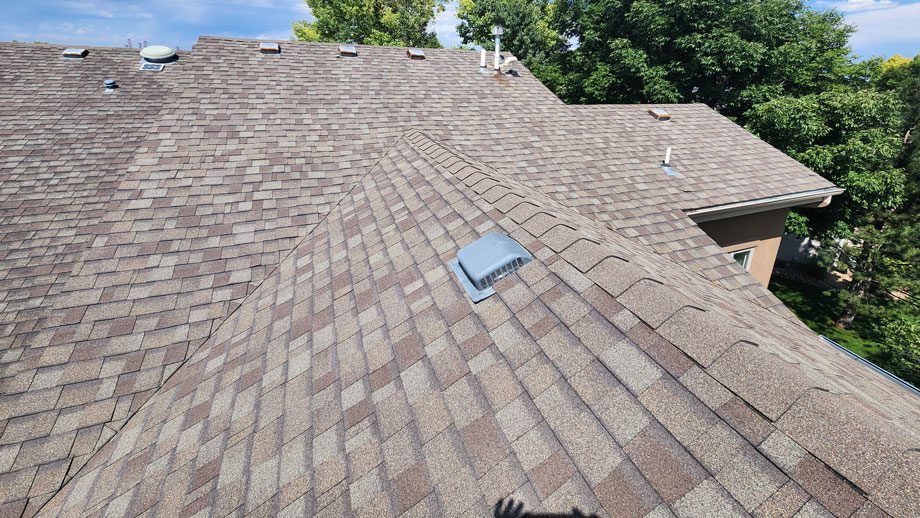
1. Consider your Climate:
The color of your roof can influence the temperature inside your home. Light-colored roofs, such as white or gray, reflect sunlight, which can help keep your house cooler in warm climates. While this can be a smart choice if you live in an area with a lot of sunlight (like Colorado), however, most people stay away from white roofs because of their appearance and lean more towards lighter grays or tans. With that being said, we have seen some great examples of “cool roofs” in a commercial setting with white membrane roofs or metal roofing. On the other hand, dark-colored roofs absorb heat, which might be beneficial in colder climates as it can help melt snow and ice off your roof more quickly.
2. Look at your home's style:
The architecture of your home should guide your color choice. Traditional homes often look good with classic colors like black, gray, or brown. Modern homes, however, can look great with bolder colors or shingles with a lot of variation. One of my favorite roofs we ever did was a deep red metal panel roof up against a primarily off-white, modern home. It was stunning.
Your roof color should complement the colors of your home’s exterior, such as the siding, doors, windows, and even the landscaping. A roof that complements these elements will pull your home’s look together nicely. For example, a gray roof can look beautiful on a house with blue siding, or a tan or brown roof can complement a home with earth-toned walls. On the other hand, we have seen customers pair a cool-toned white roof with a warm-toned, bold color, and the end result was less than impressive.
3. Look at the neighborhood:
Check out the roofs of nearby homes. While you don’t need to match them exactly, choosing a color that fits in with your neighborhood can help your home blend in or stand out, depending on your preference. Some neighborhoods throughout Northern Colorado, for instance, only have tile roofs. If your neighborhood has a specific style that is present throughout, this may make your roof replacement decision easier.
4. Think about longevity:
Trends come and go, but a roof lasts for decades. Rather than just picking something trendy, choose a color that you will still like years from now. Choosing a roof color that could blend with varying color schemes is a good idea. You will likely repaint the exterior of your home at least once during the life of your roof. It only makes sense to choose a versatile color.
5. Check for HOA Guidelines:
Check their guidelines if you live in a community with a homeowners’ association (HOA). Some HOAs have roof color rules, so choosing a color that complies with those rules is important. Many HOAs, my own included, also have rules about the materials that can be used for a roof replacement. We had to lobby to add a small section of metal roofing over the covered patio. It’s an expensive replacement if they make you change it.
6. Factor in the roof material:
Different roofing materials, like asphalt shingles, metal, or tile, can come in various colors. So it is important to consider how the material you choose will look in your desired color. Grey can vary drastically between metal panels and asphalt shingle roofs. Some roofs’ reflective designs also impact the color, so it’s important to view potential roof replacement materials in the outdoor light throughout the day.
7. Consider Energy Efficiency:
Some roofing materials and colors are designed to be more energy-efficient, helping to reduce your home’s energy costs. Metal roofs, for instance, allow for additional insulating panels to be installed under the roof for extra insulation. Look into options that can help improve your home’s efficiency while still providing the look you want.
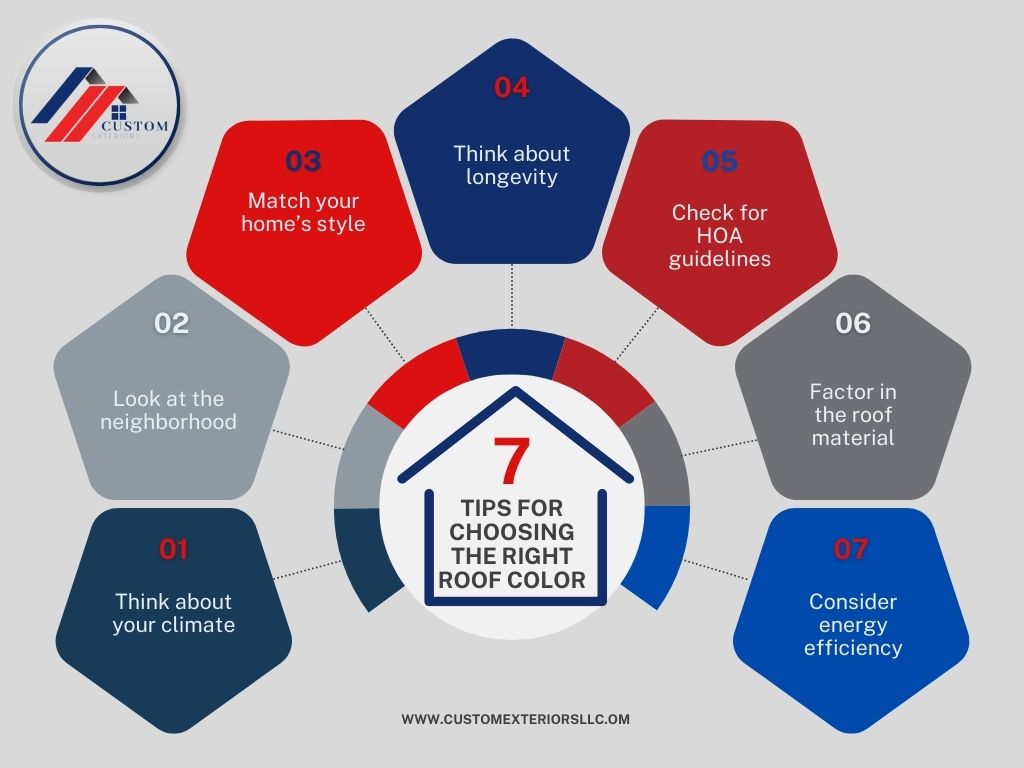
Accent Features and Finishing Touches
As we discussed earlier, your roof can make up about 40% of your home’s exterior. That makes your roof a significant and noticeable part of your home, so choosing the right color is important. A roof is a major investment, so having to replace it because you used an unapproved color could be a very expensive mistake. It costs over $10,000 to replace most residential roofs, and that number can quickly skyrocket with increased sizing or custom material choices.
When you complete an exterior remodel, everyone considers roofing, siding, windows, and paint, but some important accent features can make or break an exterior remodel. These finishing touches can significantly impact your home’s curb appeal. So what are they?
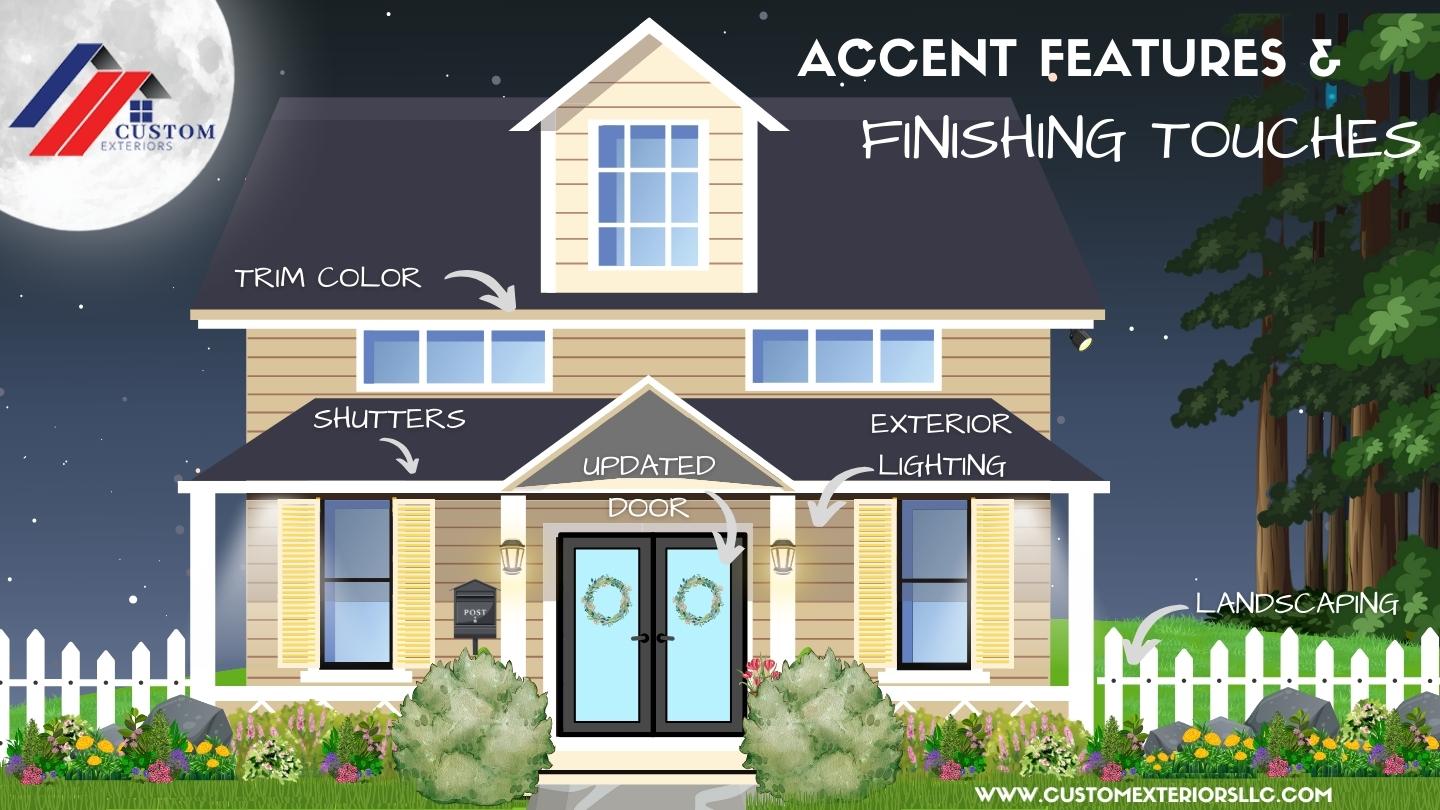
1. Choose the Right Trim: Trim acts like a frame around your home, outlining windows, doors, and other areas. Selecting the right color for your trim can highlight your house’s unique features. Typically, you want a trim color that contrasts slightly with your siding to make your home’s lines stand out. For example, the illustration shows a home with muted shades of yellow and beige and bright white as a striking trim color. Be careful when choosing dark trim colors, such as black or navy, as they can overshadow other colors quickly. Additionally, some of our favorite exterior paint color schemes include several accent colors, highlighting architectural features and creating contrast.
2.Update Your Front Door: Your front door can be a focal point of your home’s exterior. Painting it a vibrant color can draw attention to your entry. Depending on the colors of your siding and roof, colors like red, blue, or even yellow can work well. While researching valuable exterior home improvements, we recently determined that a study by Zillow found that a black door can add nearly $6500 to your selling price.
3. Consider Window Frames and Shutters: Window frames and shutters offer additional opportunities for incorporating accent colors. You can match these to your front door for a cohesive look or choose an accent color that fits with your home’s overall color scheme. This not only adds visual interest but also boosts the curb appeal of your exterior. Window shutters are available in almost every color and have several styles that make them a great fit for most architectural styles, including shutters for a modern exterior!
4. Add Lighting Fixtures: Good lighting can transform the exterior of your home and increase its safety and security. Choose fixtures that match the style of your home, and then work with a professional electrician who can ensure they are placed in the best spot. Exterior lighting should be used to light areas like the front door, walkways, and unique landscaping or architectural features of your home.
5. Landscaping Touches: Finally, consider the role of landscaping in finishing your home’s exterior. Well-maintained landscaping, flowering plants, and even decorative stones can add color and texture to your property. Think about adding planters near the entrance or along the driveway, filled with plants that complement your exterior color scheme.
Each of these finishing touches, when carefully planned and chosen, works together to create a gorgeous exterior. The goal is to create a harmonious look that reflects your style and works perfectly with the architectural style of your home.
The benefits of a well designed exterior
Choosing the right color for your roof and coordinating with your home’s exterior color scheme is a decision that can influence your home’s value and curb appeal. The impact of these color choices touches on both financial returns and practical benefits.
Homes with well-thought-out exterior colors, including the roof, can sell for more. Moreover, according to the National Association of Realtors, investing in a new roof can not only improve the look of your home but also bring a return of 107% on its cost at resale. This statistic shows just how significant the roof is in the overall value of your property.
On a practical note, the choice of roof color can affect your energy costs. Lighter-colored roofs reflect sunlight, which helps in keeping your home cooler during warmer months. The U.S. Department of Energy supports this, stating that cool roofs can save homeowners between 7-15% in total cooling costs. This not only helps reduce ongoing expenses but also makes your home more attractive to potential buyers who are conscious of energy efficiency and environmental issues.
Because cool roofs can reduce the roof surface temperature by up to 100 degrees Fahrenheit, they can reduce annual air conditioning use by as much as 15%. ~ U.S. Department of Energy
A well-chosen roof color not only adds to your curb appeal but can also significantly impact your energy costs. Whether you are updating your roof to improve its appearance, restoring damage from a storm, or preparing it for sale, remember that the color of your roof can play a significant role in the appearance of your exterior remodel.
By implementing careful planning with the information learned today, you can create a rewarding investment in your property—an investment that makes your home more attractive to you, your visitors, and potential buyers alike. If you are in Colorado, contact Custom Exteriors today to meet with one of our exterior design specialists and make your home the envy of the neighborhood!
Contact Us Today
We Service and Support the Following Brands





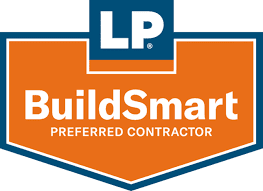



Contact
Custom Exteriors, LLC
2881 S. 31st Ave, Greeley, CO 80631
109 E. 17th St. Ste 5822, Cheyenne, WY 82001
102 S. Tejon St. Ste 1100, Colorado Springs, CO 80903
404 Broadway, Eagle CO 81631
Phone: 970-460-8714
Toll Free: 800-580-0131
Quick Links
© 2022 Custom Exteriors, LLC

